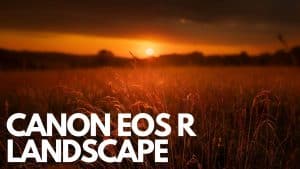When you purchase through links on our site, we may earn an affiliate commission. Here’s how it works.
Adjusting Canon EOS R Landscape Settings for Landscape Photography
Landscape photography requires attention to detail and the right equipment to capture the essence of nature. The Canon EOS R, a favorite among professional photographers, features a flexible Vari-Angle LCD screen that enables shooting from various perspectives, including low angles.
This capability ensures precise exposure and composition. The camera’s sensor is designed to be dust-proof, enhancing durability, and the shutter curtain automatically activates to protect the sensor when the camera is turned off.
How to Shoot Outstanding Landscape Photographs with Canon EOS R?
Step 1. Circular Polarizing Filter is Extremely Beneficial
A Circular Polarizing Filter can significantly enhance landscape photography by reducing glare and atmospheric haze and enriching colors. This filter allows controlled light management by rotating it to achieve desired effects. The Canon EOS R’s viewfinder aids in assessing these adjustments, and its auto-exposure feature compensates for the light loss caused by the filter, approximately 1.5 to 2 stops.
Step 2. Advantage of Focus Peaking
The Canon EOS R stands out as one of the few non-cinema EOS cameras to offer focus peaking, a feature crucial for ensuring sharp focus in manual mode. Focus peaking highlights areas of contrast, indicating where the focus is sharpest. This feature is accessible when the lens is set to manual focus, and it provides a visual aid for adjusting focus precisely.

Step 3. Easy Customization for One-of-a-Kind Effect
The EOS R’s design caters to creative expression, supported by the EF-EOS R Mount Adapter. This adapter facilitates the use of EF and EF-S lenses without compromising AF speed or image quality, extending the camera’s versatility and creative potential.
Step 4. Varying ND Filter for Capturing the Real Essence of Nature
A Variable ND Filter is indispensable for dynamic nature scenes, such as moving water. It allows for precise control over exposure, enabling motion capture with clarity and depth. Optimal settings include a shutter speed between 1/4 to 1/8 second and an aperture stopped down to f/16 for maximum depth of field, with ISO settings around 100 – 200 to ensure the highest image quality.
Step 5. Optics for Better Performance in Landscape Photography
Canon’s engineering innovations have led to the development of the RF mount, featuring a large 54mm inner diameter and a short 20mm flange-back distance. This design facilitates the creation of lenses with larger rear elements, such as the RF 50mm f/1.2L USM, offering exceptional image quality and performance for landscape photography.

Step 6. Reach Out Emotions
Capturing the emotional essence of a landscape can make your photographs stand out. Consider the mood and story your scene conveys, such as the playful movement of birds or the power of an incoming wave. Understanding and capturing these emotions can significantly enhance the impact of your landscape photography.
Step 7. Look for a Focal Point
A focal point adds interest and depth to landscape shots. Its placement within the frame is crucial, whether it’s a distinctive tree, rock, or other element. This approach helps to guide the viewer’s attention through the image, creating a more engaging composition.
Step 8. Capture Dramatic Skies in Your Landscape
The sky is pivotal in landscape photography, adding drama and depth. Utilizing filters, such as a polarizing filter, can enhance color and contrast. Experimenting with white balance settings can also yield dramatic sky effects, especially during the golden hours of sunrise and sunset.
Step 9. Cooperate with the Weather
Weather conditions can dramatically alter the mood of a landscape. Embracing varied weather, from storms to sunsets, can add a unique dimension to your photography. Such conditions offer opportunities for capturing landscapes with rich emotions and atmospheric depth.
The Canon EOS R’s advanced features, including a 30.3-megapixel CMOS sensor, DIGIC 8 image processor, and the revolutionary RF mount system, make it an exceptional tool for landscape photography.
Its ability to shoot in high resolutions, with a wide ISO range and Dual Pixel CMOS AF, ensures photographers can capture landscapes with precision and creativity.
See Also